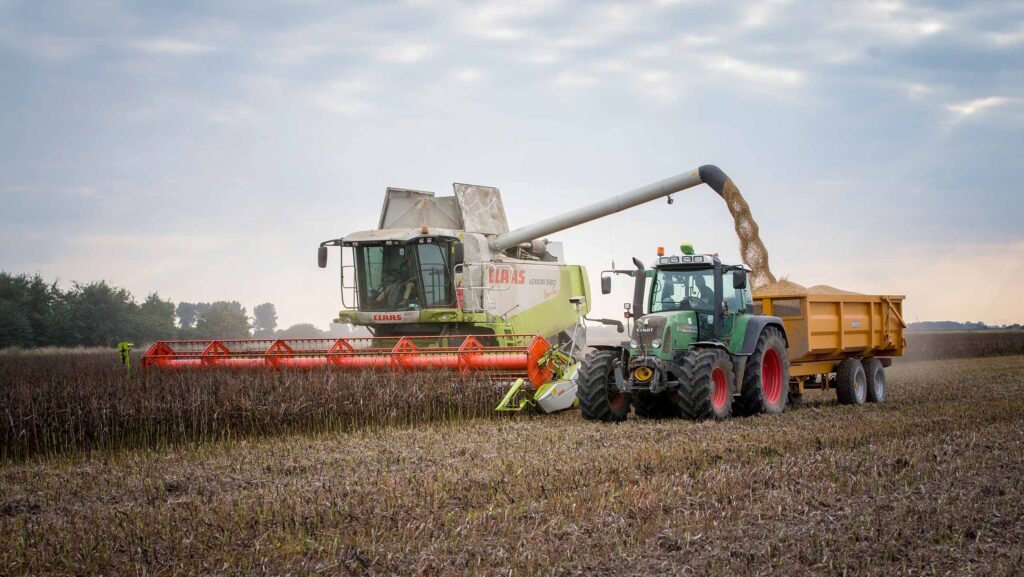Harvest 24: Season drags as combines dodge autumn showers
 © GNP
© GNP Combines are still making progress between the showers, with significant yield variations both within fields and across the country.
County Down
Graham Furey is 75% through harvest at Castleview, Killyleagh, with the final cut of spring barley due from lunchtime today (September 13).
Yields have been variable, with the 40ha of Tardis and Belfry winter barley averaging 6.1t/ha, down on the usual 8.7t/ha. Specific weights are averaging 66kg/hl.
See also: Harvest highs and lows from Arable Insights farmer panel
The 38ha of Pallidum, Extase and Graham winter wheat averaged 7.4t/ha, which is also back on its usual norm of 8.7t/ha.
“The specific weight was in the high 70s and early 80s straight after combining,” he says. “Considering the lack of sunshine, the grains swelled well.”
The 15ha of Mascani winter oats achieved a stronger yield at 7.4t/ha, compared to last year’s 5t/ha, which was a welcome surprise after experiencing flooding and compaction across different areas of the farm.
Graham is cautiously optimistic about the remaining 20ha of Hurler and Skyway spring barley.
“I am hoping to get around 6.2t/ha, but I hear in places, some farmers are hitting as much as the 9.8t/ha mark where there have been exceptional fields, which is unheard of around here. Nobody really knows why, but we aren’t complaining.”
County Durham
Across in the East, Michael Manners has finished his 60ha of wheat harvest at Coniscliffe Grange, Darlington, with yields down by 1t/ha compared to last year.
The 283ha of Typhoon, Dawsum, and Champion produced 8.6/ha, 1.2t/ha below the farm’s average.
“There were significant variations in yield between fields, from 7.4t/ha to 9.9t/ha, due to bare and flooded patches,” says Michael. “Typhoon was the standout variety for us.”
The 50/50 split between Caravelle and Funky feed barley yielded a disappointing 8t/ha. However, the quality held up, with specific weights at 65kg/hl and moisture content at 16%.
The remaining 112ha of spring beans are set to be harvested today (13 September). Although Michael is optimistic about the crop’s appearance, he is keen to wrap up the season.
“It’s been a challenging year overall,” he admits.
“While the results are disappointing, they are not unexpected. We’ve done a lot of subsoiling and upgraded our drainage ahead of this year’s drilling, and we’re hoping for better results.”
Cambridgeshire
Although harvest began with significant challenges, operations were a “doddle” at Offord Hill Farm in Godmanchester, says Anthony Carr.
A severe blackgrass infestation forced him to cut 36ha of winter wheat for silage. “After drilling last season, the wet weather made it impossible to spray. We managed to get a cut, but a lot of the land stood empty.”
Cochise spring wheat averaged 7.6t/ha, with good Hagbergs at 265 and a protein content of 12.9%. However, the 28ha of Caravelle and Bolton winter barley fell short, yielding a disappointing 6.9t/ha at 65kg/hl, down from last year’s 7.9t/ha.
Despite a relatively cleaner season, spring beans were still affected by bruchid beetle, leading to a yield of 3.4t/ha.
“Harvest has been easy, and the weather stayed dry,” adds Anthony. “But the yields are nothing to shout about. We just need to focus on drilling for next season and hope for a better outcome.”
Hampshire
Winter wheat harvest began in July at the Trinley Estate, near Andover, unusually early for the farm, says Mike Powell – occurring only two years in every 10.
The Group 4 hard wheats included Champion, Costello, and Dawsum, with Champion yielding the best at 9-9.5t/ha, on par with last year but slightly below the five-year average of 10t/ha.
Dawsum came in at 9t/ha, with Costello around 8.5t/ha. Protein content was just below 10%.
This year, a three-way blend of Palladium, Graham, and Extase was trialled for the first time, and it outperformed expectations, all achieving over 10t/ha.
Laureate spring barley was sown later than usual, from mid-April, yielding 7-8t/ha – better than the circumspect budget of 6.5t/ha.
“The quality was good, with 1.6% nitrogen and low screenings,” says Mike. “Overall, 930ha has been put through the combine across three farms, and the results have been solid.”

